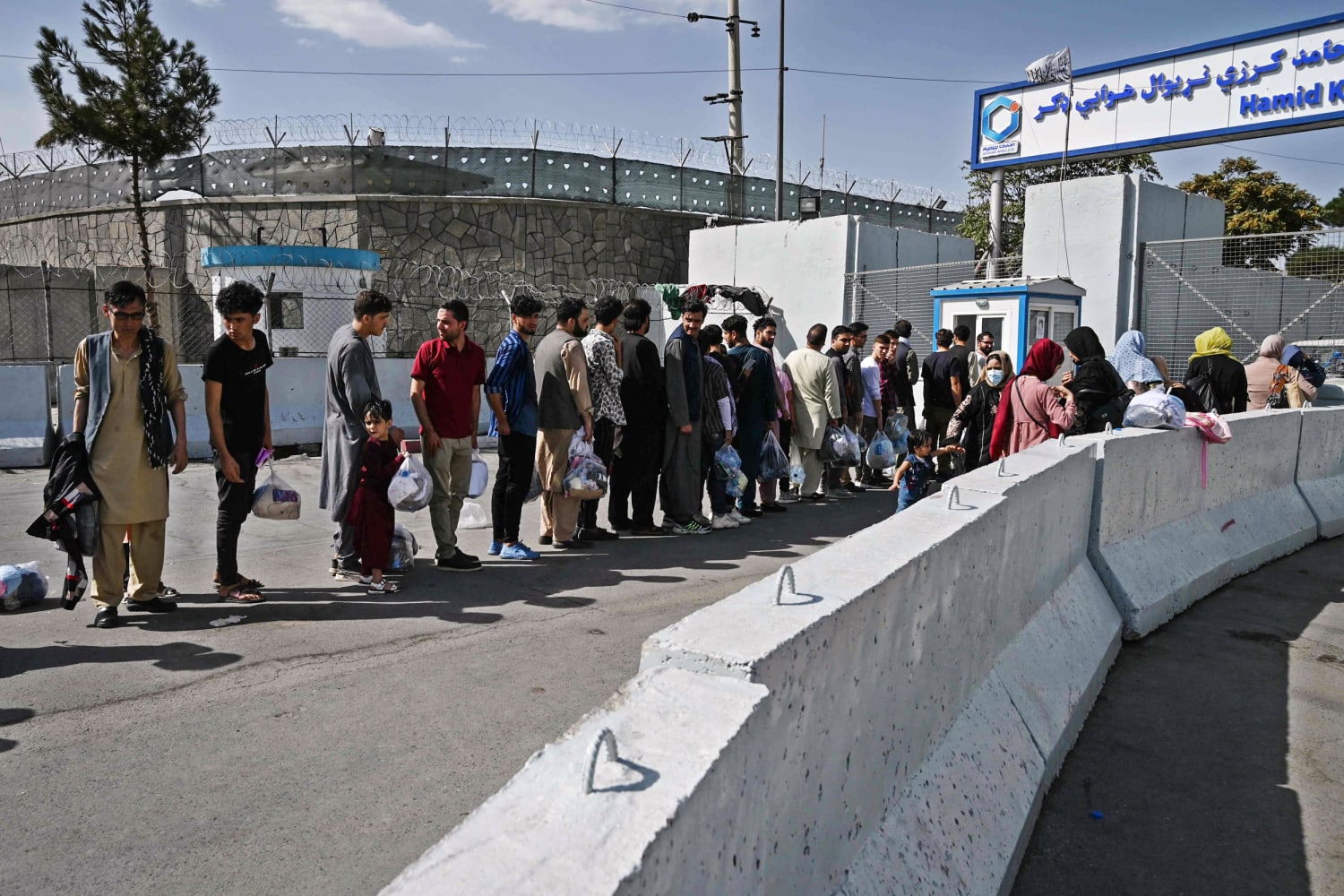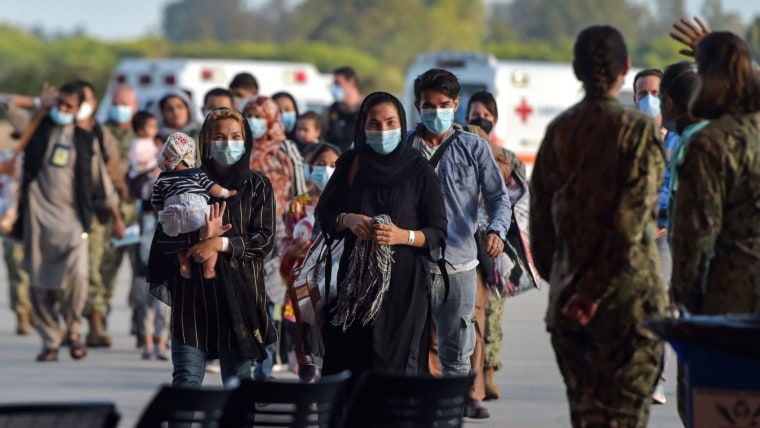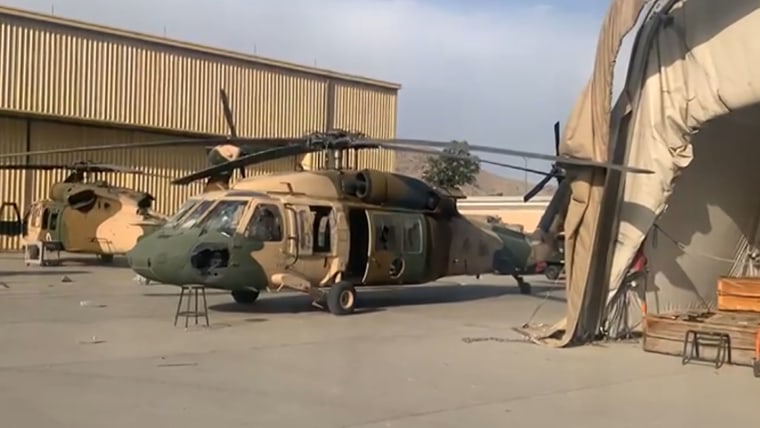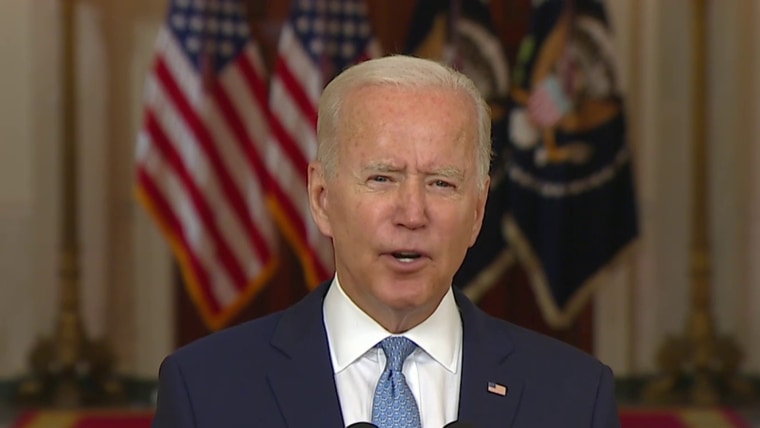WASHINGTON — More than 120,000 people of all nationalities were evacuated from the Kabul airport as the U.S. military withdrew, but initial figures suggest that only about 8,500 of those who left Afghanistan in recent months were Afghans, according to numbers released by the Biden administration and estimates from advocates.
That is a small percentage of the tens of thousands of Afghans who worked for the U.S. government or U.S. organizations and applied for special U.S. visas, and an even smaller percentage of the Afghans eligible to apply.
As the U.S. military mission drew to a close over the past month and the Taliban rolled into Kabul, the Biden administration said the evacuation effort would place a priority on flying out American citizens and Afghan “partners” who applied for what are known as Special Immigrant Visas (SIVs).
As of May, about 18,000 to 20,000 Afghans who worked with U.S. troops and diplomats had applied for SIVs, according to government figures. When their family members are included, the pool of Afghans in the SIV program was at least 70,000 and probably higher, according to refugee advocacy groups.
But only about 8,500 Afghans appear to have made it out on evacuation flights that began in July, according to estimates from nongovernmental organizations and advocates and the figures released so far by the Biden administration.
The Pentagon indicated last week that nearly 7,000 Afghans had been evacuated to bases in the U.S. And on Monday, Gen. Kenneth McKenzie, commander of U.S. Central Command, said that about 1,500 Afghans had been airlifted out in the final stage of the evacuation before the last troops departed.
It’s unclear whether all of those evacuees were in the SIV program. U.S. officials have yet to offer an overall estimate of the number of Afghans in the program who were evacuated to the U.S. or to third countries, making it difficult to pin down exactly who made it out of Kabul in the frantic closing days of the U.S. military presence.
According to advocates, however, as many as 265,000 Afghans and their families may have had some form of eligibility to apply for a U.S. visa because of their work with U.S. governmental and nongovernmental organizations during the past two decades.
The SIV program was set up more than a decade ago to help Afghans at risk due to their work with the U.S. military to resettle in the United States. But the program had been plagued by bureaucratic delays, with some applicants waiting years for their papers to be processed.
In addition to the 70,000 or more Afghans who were approved for SIVs or had pending applications, another pool of Afghans and their families — perhaps an additional 50,000 people — were eligible for the program because of work with the U.S. government but did not apply or were rejected for unknown reasons, according to an estimate from the Association of Wartime Allies, which works with Afghan allies.
That number covers Afghans who were employed by the U.S. military or other agencies over the past 20 years, along with members of their immediate families, according to the group’s findings.
Separately, a large number of Afghans who were not eligible for SIVs but were eligible for other forms of expedited U.S. visas due to their association with U.S.-funded groups or projects were not evacuated. That group, including families, could number another 145,000 Afghans, according to the AWA’s estimates. The AWA’s figures do not indicate how many made it out of Afghanistan, or wanted to leave, or applied to leave, or had their applications rejected. This class of potential evacuees was only recently made eligible for expedited U.S. visas, so data about applications and acceptances is scant.
The AWA said it based its estimates on a review of publicly available data published in reports by the Defense Department, State Department, and other non-governmental organizations and research organizations.
The research was overseen by a professional demographer and faculty at American University, said a member of the AWA’s advisory board.
A State Department spokesperson said the Biden administration could not provide “precise statistics about processing at this time … because our focus has been on executing one of the biggest airlifts in history.”
“The Biden administration has demonstrated, in the face of significant challenges, its sacrosanct commitment to the thousands of brave Afghans who have stood-by-side with the United States over the course of the past two decades,” the spokesperson said.
The administration, however, has come under sharp criticism from lawmakers from both sides of the aisle and from veterans’ groups over how the evacuation was handled, with critics accusing the White House of abandoning Afghans who risked their lives for the United States.
“The numbers speak for themselves,” said Chris Purdy of Human Rights First, who along with other advocates had urged the administration to launch an evacuation months earlier.
“This outcome was completely avoidable. Had the administration listened to the many organizations and individuals who had been calling for an evacuation since the first announcement of the withdrawal timeline back in April, the evacuation could have taken place alongside the U.S. military withdrawal instead of afterward,” said Adam Bates, policy counsel at the International Refugee Assistance Project.
The State Department spokesperson said the administration had inherited a major backlog of applicants to the SIV program when it came into office as well as a Covid-19 outbreak in Afghanistan that hampered embassy efforts to process visas.
Despite those challenges, “we dramatically accelerated SIV processing and launched an unprecedented and ongoing effort to relocate Afghan Special Immigrants to safety,” the spokesperson said in an email.
Defending his handling of the U.S. troop withdrawal, President Joe Biden said on Tuesday that starting the evacuation earlier would not have changed the outcome. In any scenario, there would have been a rush to the airport, and staying longer would have meant escalating the conflict with the Taliban, Biden said.
The president called the evacuation effort an “extraordinary success.” The administration says U.S. and allied aircraft evacuated more than 123,000 civilians from Kabul in recent weeks, including several thousand U.S. citizens. But that number includes nationals from NATO member states and other countries.
Source: | This article originally belongs to Nbcnews.com












